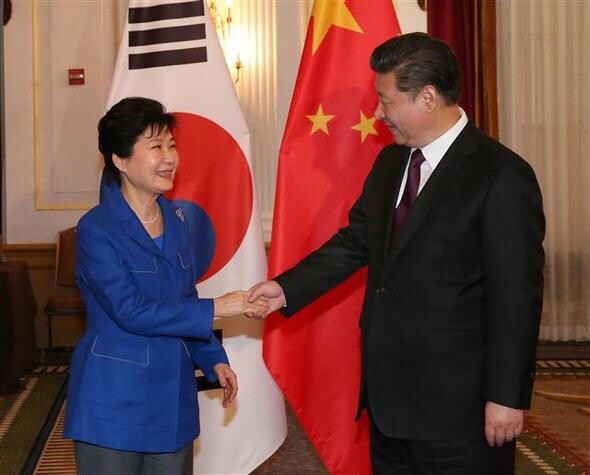hankyoreh
Links to other country sites 다른 나라 사이트 링크
After summit, S. Korea, US and Japan expected to step up military cooperation

Military cooperation among South Korea, the US, and Japan is expected to gain traction after their leaders agreed to strengthen trilateral collaboration on security at the Nuclear Security Summit on Mar. 31.
South Korean President Park Geun-hye, US President Barack Obama, and Japanese Prime Minister Shinzo Abe previously helped usher in stronger trilateral cooperation by tackling frictions between Seoul and Tokyo during a trilateral summit at the Nuclear Security Summit in The Hague two years ago.
Specific discussions on trilateral military cooperation appear set to take place at a meeting of Defense Ministers - likely at the Singapore Shangri-La Dialogue in May - and at Defense Trilateral Talks (DTT) to be held during the first half of the year. The Defense Minister talks are a particular focus of attention as the first trilateral security discussions since recent security legislation went into effect in Japan allowing its Self-Defense Forces (JSDF) to legally wage war. Specifically, the JSDF is allowed to exercise its collective self-defense authority by providing active rear support to protect US forces deployed to the Korean Peninsula in the event of an emergency.
Later trilateral talks are now expected to include serious discussions on the types and scope of JSDF military activities in such a situation. But many argue that the expansion of JDSF activities should be approached carefully due to possible infringements on South Korea’s sovereignty.
Trilateral missile defense cooperation also looks poised to gather momentum. This year, South Korean and US authorities are planning to connect the Korea Air and Missile Defense (KAMD) system with the US Forces Korea USFK) missile defense system in a single network for the real-time exchange of information on North Korea’s missile program. The linkage of South Korea and the US’s missile defense systems would mean a three-way network also encompassing Japan, as USFK is already linked with Japan’s missile defense system.
But many are voicing concerns that the ultimate aims of the stronger trilateral military cooperation extend beyond North Korea to target China.
By Park Byong-su, senior staff writer
Please direct questions or comments to [english@hani.co.kr]

Editorial・opinion
![[Column] Park Geun-hye déjà vu in Yoon Suk-yeol [Column] Park Geun-hye déjà vu in Yoon Suk-yeol](https://flexible.img.hani.co.kr/flexible/normal/500/300/imgdb/original/2024/0424/651713945113788.jpg) [Column] Park Geun-hye déjà vu in Yoon Suk-yeol
[Column] Park Geun-hye déjà vu in Yoon Suk-yeol![[Editorial] New weight of N. Korea’s nuclear threats makes dialogue all the more urgent [Editorial] New weight of N. Korea’s nuclear threats makes dialogue all the more urgent](https://flexible.img.hani.co.kr/flexible/normal/500/300/imgdb/original/2024/0424/7317139454662664.jpg) [Editorial] New weight of N. Korea’s nuclear threats makes dialogue all the more urgent
[Editorial] New weight of N. Korea’s nuclear threats makes dialogue all the more urgent- [Guest essay] The real reason Korea’s new right wants to dub Rhee a founding father
- [Column] ‘Choson’: Is it time we start referring to N. Korea in its own terms?
- [Editorial] Japan’s rewriting of history with Korea has gone too far
- [Column] The president’s questionable capacity for dialogue
- [Column] Are chaebol firms just pizza pies for families to divvy up as they please?
- [Column] Has Korea, too, crossed the Rubicon on China?
- [Correspondent’s column] In Japan’s alliance with US, echoes of its past alliances with UK
- [Editorial] Does Yoon think the Korean public is wrong?
Most viewed articles
- 1‘We must say no’: Seoul defense chief on Korean, USFK involvement in hypothetical Taiwan crisis
- 2N. Korean delegation’s trip to Iran shows how Pyongyang is leveraging ties with Moscow
- 346% of cases of violence against women in Korea perpetrated by intimate partner, study finds
- 4Amnesty notes ‘erosion’ of freedom of expression in Korea in annual human rights report
- 5‘Weddingflation’ breaks the bank for Korean couples-to-be
- 6[Column] Park Geun-hye déjà vu in Yoon Suk-yeol
- 7Will NewJeans end up collateral damage in internal feud at K-pop juggernaut Hybe?
- 8Korea sees more deaths than births for 52nd consecutive month in February
- 9“Parental care contracts” increasingly common in South Korea
- 10[Interview] Dear Korean men, It’s OK to admit you’re not always strong